Grid trading follows a simple concept. But it’s a powerful way to profit from market swings. Instead of chasing big moves, you aim to make many small trades as prices move up and down. To achieve this end, you’ll use a grid trading bot that automates this buying and selling at certain price levels that create a grid on the chart.
Today’s crypto grid trading bots range from advanced tools like the 3Commas grid bot AI strategy to some simpler options like the Pionex spot grid bot. In this article, I’ll cover the best grid trading bots and show you the best settings and tips so you can use them as well as you possibly can.
What are Grid Strategies?
A grid strategy is a trading method that places multiple buy and sell orders at set price intervals. These orders form a grid pattern on the chart. The goal is to profit from price fluctuations within a certain range. So, you won’t need to predict the exact direction of the market.

When the price drops to a lower grid level, the bot buys. When it rises to an upper grid level, the bot sells. Each completed buy and sell pair locks in a small profit. Over time, these small wins can compound into much larger returns. This strategy works great in markets that move sideways or range between support and resistance.
Now, why are grid strategies so popular? Well, because they work in both spot and futures markets. You can make them adapt to different asset classes like crypto, forex, and even stocks. They are also easy to automate using grid trading bots.
Types of Grid Strategies
There are a handful of different grid trading strategies in crypto. Here are the most popular ones:
- Spot Grid: It uses only available funds without leverage. For those of you who want low risk and like to accumulate for the long term, spot grid trading bots are perfect.
- Futures Grid: Getting to the riskier option, futures grid bots use leverage to increase position size. Only use these strategies if you have enough experience and risk tolerance.
- Infinite Grid: These bots keep running without a fixed upper or lower price limit. The strategy is adjusted as the market moves, and due to no limits, it works best on trending markets.
- Reverse Grid: The reverse grid strategy makes profits from a falling market by selling high and buying lower as the trend continues down.
- AI-Optimized Grid: In these strategies, AI uses market data to automatically adjust settings. These include grid spacing, size, and targets.
How to Set the Best Grid Settings?
Now, just using a grid strategy or bot won’t cut it. You’ll have to set optimal settings and take certain steps to make your grid strategy work best. Let’s see how you can figure out these settings.

Matching Grid Trading Bot Settings to the Asset
The best grid settings depend on the asset you’re trading. They should align with your asset’s volatility and also your exchange’s fee structure.
For spot trading on major pairs like BTC and ETH, a decent grid spacing is between 0.3% and 0.5%. This usually keeps profits per trade above the combined taker and maker fees, which on most exchanges total around 0.2%.
The goal is to make sure every filled order leaves you with a meaningful gain after costs (fees).
Choosing the Number of Grid Levels
Your grid count depends on the width of your range and current market conditions. I mean, in higher volatility, using 15 to 20 grid levels allows you to capture more frequent movements without overcrowding the range. And, in calmer markets, widening the range and running 20 to 30 levels keeps the bot active without triggering excessive small trades.
For capital allocation, you can assign around 3% to 7% of your total budget per grid level. If you’re confident in the asset’s price stability, you can also adjust it higher.
Using Platform Presets as a Starting Point
Some exchange-provided presets can help you get started quickly. For example, Binance’s “Medium Risk” AI grid mode is a balanced option for both spot and futures markets.
Pionex also offers an AI grid bot that calculates range and levels automatically based on recent volatility. Note that if you trade futures, it’s wise to keep leverage no higher than 3× to reduce liquidation risk during sudden price moves.
Building Custom Grids with ATR
A more calculated approach that I personally like is using indicators like ATR (Average True Range) to determine grid spacing. This method sets the lower bound just below recent support and the upper bound near recent resistance. The spacing is based on a multiple of ATR.
As a result, your grid can adapt to the asset’s recent volatility instead of relying on fixed gaps. So, you’ll have a more statistically sound approach, which I think will give you an edge over others.
Testing and Adjusting Your Grid Trading Bot Settings
Now you know some crucial details about optimizing the grid settings. Yet, before going live, you should backtest these on platforms like 3Commas, WunderTrading, or Coinrule. Even if you think you have the best grid trading strategy at hand, I always suggest testing it before putting real money down.
Backtesting, which is a historical simulation, helps you see how your bot would have performed in the past. It also reveals whether your range or spacing needs more tuning or not.
After the backtesting phase and when you go live, remember to monitor performance for at least a week. Grid trading works best when parameters evolve with market conditions. You should always be ready to adjust as volatility and price structure change.
Best Grid Trading Bots in 2025
The grid trading bot market is full of options. But a few platforms always stand out for reliability, flexibility, and some unique features that suit both individual traders and asset managers.
The right choice, of course, depends on your preferred level of control, the assets you trade, and whether you want AI assistance or a fully manual setup. Let’s take a brief look at the best grid trading bots in 2025:
|
Platform |
Best for |
Key features |
Exchange support |
Pricing |
|
Pionex |
Spot grids with minimal overhead |
Built in grid bots for spot and futures, AI grid option, very low trading fees |
Pionex exchange only |
No subscription fee. Spot trading fee is 0.05% per trade. |
|
3Commas |
Advanced manual control and asset managers |
AI and manual grid, DCA, backtesting, SmartTrade |
Major exchanges like Binance, Bybit, OKX, Coinbase, Kraken, KuCoin, and more. |
Free plan. Pro $ 37/month. Expert $59/month. Asset Manager $374/month. |
|
Coinrule |
Rule-based grids with conditions |
If this then that rules, grid plus indicators, backtesting, TradingView signals on higher tiers |
Binance, Coinbase Pro, OKX, Kraken, Bitpanda, and others. |
Starter Free. Investor $29.99/month. Trader $59.99/month. Fund $749/month. |
|
Cryptohopper |
All-in-one automation with marketplace |
Grid for spot and futures, strategy designer, backtesting, copy bots |
Binance, Coinbase Advanced, Kraken, KuCoin, OKX, Bybit, Bitvavo, HTX, Bitfinex, HitBTC, and more. |
Pioneer Free. Explorer from $24.16/month with annual billing. Adventurer from $57.50/month with annual billing. Hero from $107.50/month with annual billing. |
|
WunderTrading |
Multi-account deployment, copy trading, grid plus DCA combos |
Grid with manual or ATR-based spacing, DCA, signal bots, copy trading, and paper trading. |
Major centralized exchanges. |
Free plan available. Basic $19.95/month. Pro $39.95/month. Premium $89.95/month. |
1. 3Commas: Flexible Grid Trading Bot with Advanced Tools
3Commas is a name you’ve definitely heard of. It’s a strong choice for you if you want complete control over your grid strategies. Its AI grid bot adapts to market conditions and does so automatically. Yet, you can also set every detail manually, from range and grid count to order sizes.
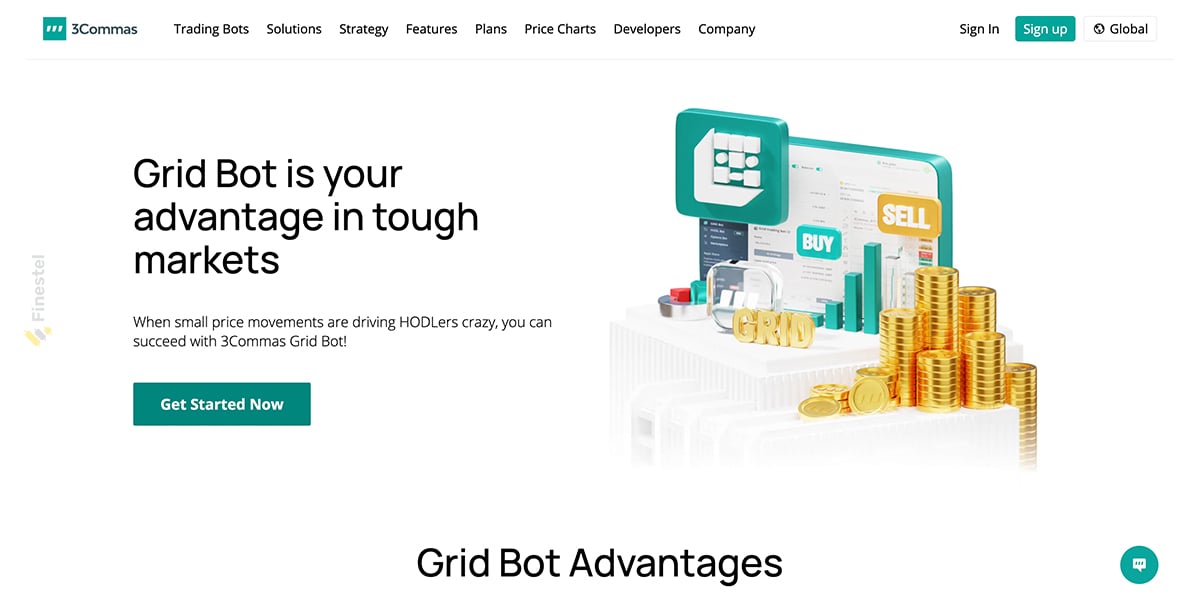
The 3Commas grid bot integrates with multiple exchanges. You can run the grid trading strategies across several accounts from a single dashboard. This is an outstanding feature for most asset managers and big money traders.
If you’re a crypto asset manager, this means you can duplicate successful grids on multiple client accounts, which can be on different exchanges. There’s no need to manually define settings each time.
Backtesting tools are also built in. They allow you to optimize your grids and grow your confidence in the strategy before going in with real funds and in the live market.
2. WunderTrading: Multi-Exchange and Strategy-Friendly
Another big name in the crypto automation space is WunderTrading. There are grid bots that you can combine with other advanced automation tools like DCA (Dollar-Cost Averaging) and copy trading.

The WunderTrading grid trading bot also supports multiple exchanges. You can build grids with both manual and ATR-based spacing to adapt to market volatility.
One of its strengths is running grid strategies in combination with other bots. You can switch between trend-following and range-trading without changing platforms. Therefore, you’ll basically be able to keep your exposure to the market, no matter the price action.
Multi-account support is also available for asset managers. You can deploy the same grid on several client portfolios simultaneously.
3. Coinrule: Rule-Based Automation with Grid Capabilities
Coinrule is mainly known for rule-based trading automation. But it can also run grid strategies as part of its overall system. You can combine grids with other triggers like RSI signals or moving average crossovers, so there’s a whole lot of flexibility.
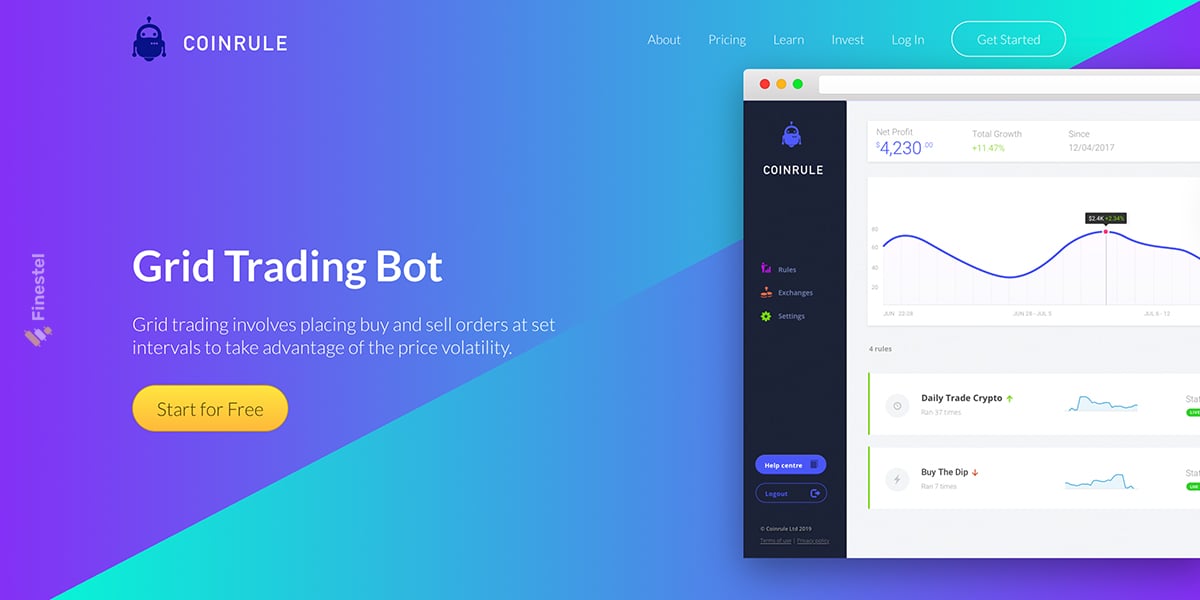
As a result, your bot only activates under specific conditions. If you want more than just a simple, always-on grid, then Coinrule can help you build it. This is one of the unique advantages that comes with using the Coinrule grid trading bot.
Again, there’s also the backtesting feature to help you refine the strategy. This is essential, in my opinion, as you’re not just using a grid trading strategy, and you’re including additional rules and indicators. You would definitely want to test the final strategy on data to see if it works well or not.
4. Pionex: Simple and Reliable Spot Grid Trading Bot
Pionex is often ranked among the best crypto grid bot providers. That’s because it builds the bot directly into its exchange.
You can choose between manual settings and the AI Grid Bot, which calculates range and levels automatically. These settings are optimized based on recent volatility.

The AI mode is a great entry point for traders who want to start quickly. It’s especially great for those of you who trade large coins like BTC and ETH in the spot market.
Pionex also offers a futures grid option for leveraged trading. Though this one is best for traders who can manage higher risk. Low trading fees are also another selling point that makes Pionex great for tighter grids that rely on small but frequent profits.
5. Cryptohopper: All-in-One Bot with Grid Features
Cryptohopper also offers a complete automation platform. Grid bots are one of its many tools. You can trade spot or futures and set your own grid parameters.
There’s also the option to combine the grid bot with technical indicators to have more precise control and improve the performance.
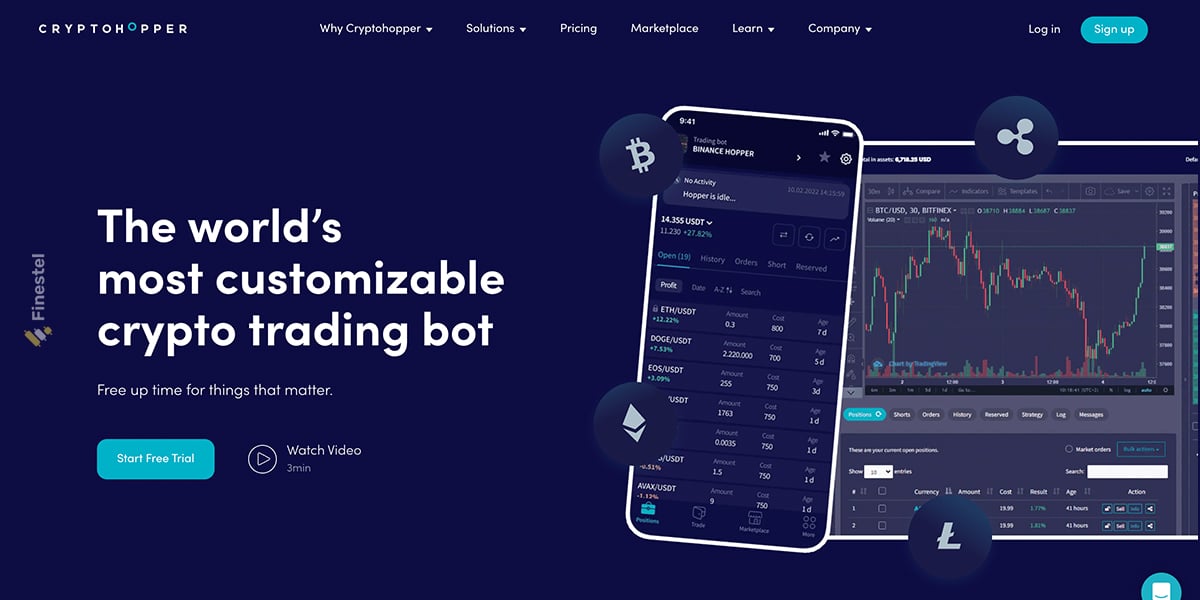
Then, there’s the Cryptohopper strategy marketplace that lets you buy or subscribe to grid setups from other traders. You can even list your own grid trading strategy there for others to follow.
If you’re a portfolio or asset manager, Cryptohopper supports multiple exchange accounts under one login. So, this is also a good option for managing client funds across different places and through only one dashboard.
Other Notable Options
While the five platforms mentioned above lead the pack, other names like Bitsgap also offer competitive grid trading features.
Exchange integration and portfolio tracking are often available on other options, too. We’ve chosen the platforms above based on user reviews and the unique features they offer. Track record is also a deciding factor, which can’t be overlooked for platforms like 3Commas and WunderTrading.
But in the end, the choice you make comes down to the assets you trade or the exchanges you trade on, your risk tolerance, and the actual degree of control you’d like to have on the grid trading bot settings.
Running Grid Trading Strategies on Multiple Accounts
So, how to run grid and DCA strategies across multiple accounts? Well, we all know doing this on one account is simple. But doing it across dozens of accounts without missing trades, messing up allocations, or manually re-entering settings is another story.
For asset managers, consistency is everything. If you are running a profitable grid bot on BTC/USDT for one client, you want the exact same entries, spacing, and exits mirrored for all your other clients. And, I don’t need to mention how slow doing this manually is. You’ll also be prone to errors, and it would almost be impossible to manage when the markets move fast. And, well, crypto is quite fast.
This is where Finestel comes in. Finestel is an ultimate asset management software, including copy trading and trading automation solutions. Our copy trading bot helps you connect multiple client accounts from several different exchanges and run your strategies on them all at once. The strategy can be grid, DCA, a combination of both, or any other trading strategy. The orders will be replicated with lightning-fast speed, minimum latency, and ultimate precision.
You can adjust one master bot or manual setup, and every connected account will execute the same trades instantly. There’s also the white-label option that you can use to create your own platform and present your business with a branded and professional look to potential investors.
Our brand new signal bot also allows you to take the alerts created by your strategies, send them to exchanges, and make orders based on them. This whole process is done in milliseconds.
How to Operate Grid Trading on Finestel?
Managing client funds with your grid trading strategies and using Finestel is very simple. You only have to do the usual. I mean, you should set your range, grid spacing, and order sizes once on the master account. Our copy trading bot will then replicate it to all followers with proportional allocations, so each client gets the same percentage exposure.
Moreover, for DCA strategies, you can set recurring buys or a dynamic scaling method on the master account. It is then linked to other portfolios on different exchanges, so they’ll follow the same plan automatically.
So if you’re a serious trader or asset manager who wants to grow your brand and play the long-term game, Finestel is the game-changer. Having this level of automation is quite the competitive edge that keeps both you and your clients way ahead of the curve.
Conclusion
Grid trading is a systematic way for us retail traders to take advantage of market swings. The strategy is simple, but when paired with the right bot and settings, it can turn into a consistent profit engine. Platforms like Pionex for its built-in simplicity, 3Commas for full customization and multi-exchange integration, and WunderTrading for combining grids with DCA and copy trading are, in my opinion, among the best options you can choose right now.
And here’s the best part. You don’t have to limit these strategies to one account. By connecting your grid trading bots to Finestel, you can replicate the same strategy across multiple accounts, on multiple exchanges, and for multiple clients. All from a single master setup. Finestel makes sure every connected portfolio executes with speed, accuracy, and perfect proportional allocations.





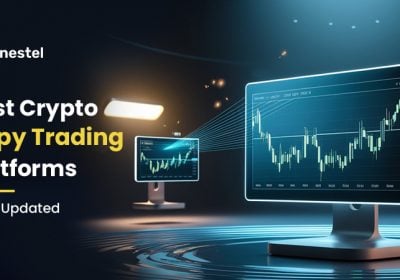
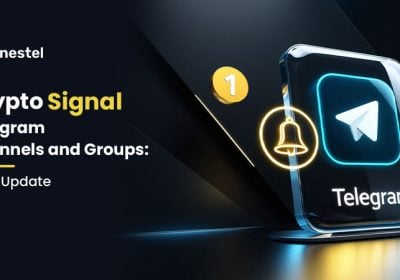
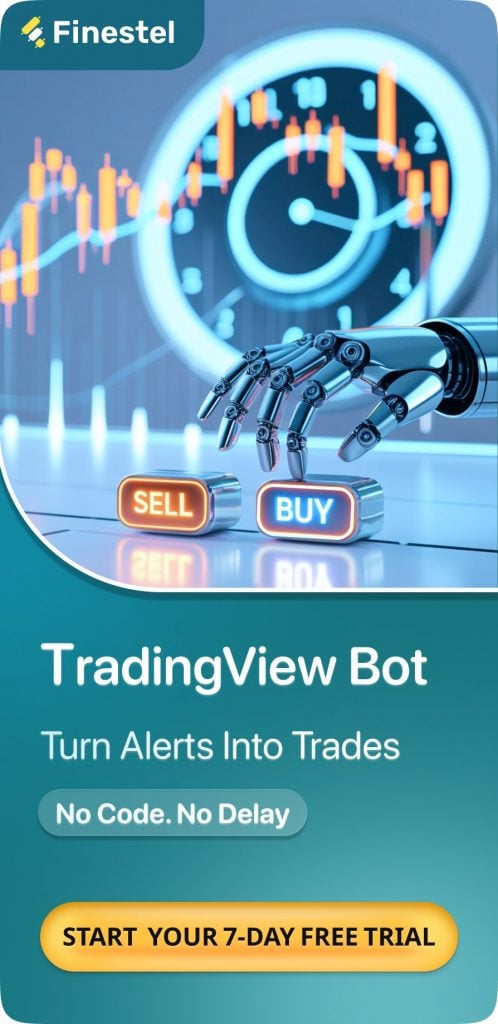
Leave a Reply